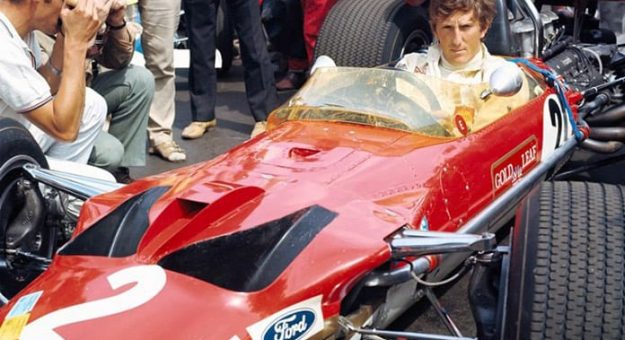During his tragically brief life, Jochen Rindt’s rich talent, on-the-edge style and magnetic charisma captured the admiration of the media, fans and his peers alike.
His was a violent era. A driver’s life expectancy was short, making for fatalistic attitudes and a cavalier approach to each and every day.
Rindt once said, “Maybe I will not reach the age of 40 …”
He didn’t make 30.
“Nobody knows how long they will live,” Rindt continued. “So you have to do as much as you can, as fast as you can.”
He certainly accomplished that.
Born April 18, 1942, in Mainz, Germany, his parents died during an Allied bombing raid in 1943.
Spoiled by the doting grandparents who raised him, Rindt became a mischief-making hellion with no interest in higher learning. Rindt and his buddy, Helmut Marko, now Red Bull’s motorsports consultant and one of Formula One’s most influential individuals, so terrorized their school that administrators offered them passing certificates if they transferred to another school, which they did.
Hoping to instill some discipline, Rindt’s grandparents packed him off to England to complete his education. There, he discovered auto racing.
Beginning with hill climbs, Rindt moved to saloon cars, and in 1963 bought a near-obsolete Formula Junior Cooper. With it, he won consistently against better equipment and more experienced drivers in the Italian Formula Junior Championship.
He jumped to Formula Two the next year, forming his own team with Ford of Austria’s backing. Running a Brabham-Cosworth, he startled Europeans by winning the prestigious London Trophy race against Jim Clark, Graham Hill and Denny Hulme.
By 1965, only three years after first stepping into a race car, he was competing in Formula One.
His three-season run with the Cooper Racing team was bleak. The cars were uncompetitive and unreliable. Still, Rindt managed 10 points-paying finishes despite completing only 13 of the 29 races Cooper entered.
While Formula One proved disappointing, Rindt excelled elsewhere. He remained virtually unbeatable in Formula Two, a series permeated with Formula One drivers. He won the 24 Hours of Le Mans in 1965 and made two consecutive appearances at Indianapolis Motor Speedway in 1967-’68.
In 1968, Rindt jumped to Brabham’s Formula One team with no improvement in reliability. He finished only two races, but was second in each of those. That caught the attention of Lotus creator Colin Chapman, who was seeking a replacement for Clark who was killed on April 7, 1968.
Chapman’s imaginative designs revolutionized racing, but his cars also carried a reputation for being dangerously fragile. That troubled Rindt.
By this time he’d matured. He married Finnish model Nina Lincoln and they had a baby daughter. He was hesitant to accept Chapman’s offer.
It was his friend, future F-1 czar Bernie Ecclestone, who convinced Rindt that he needed Lotus to become a world champion. Despite his reservations, Rindt joined Lotus for 1969.
“I will either become world champion or get killed in a Lotus,” he insisted.
Initially, he fared no better at Lotus than with his previous teams, falling out of the season’s first four races. In Spain, a wing strut broke and he crashed horrendously. He was left with a concussion and increased reservations about Lotus.
He recovered, however, to score his first Formula One victory at New York’s Watkins Glen circuit.
For 1970, Chapman unveiled perhaps the most significant car in racing history, the Lotus 72. Rindt was not happy with it and stuck with the older Lotus 49C to win Monaco on the last lap.
After Monaco, Chapman had the 72C ready. A tremendous improvement over the original 72, Rindt won four consecutive races before being forced out during the Austrian Grand Prix.
Then came Monza.
During practice on Sept. 5, Rindt charged into the infamously fast Parabolica bend and a brake-system part failed. He was killed in the crash.
Rindt had amassed enough points to be posthumously crowned world champion.
